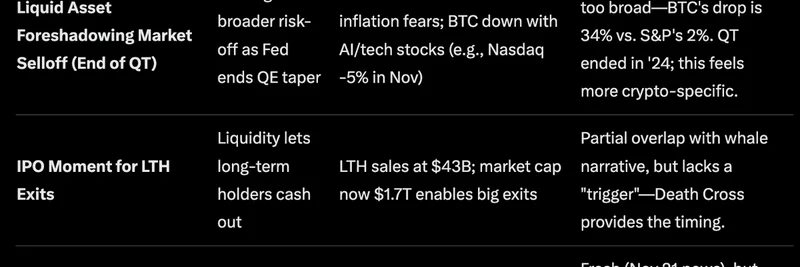In the fast-paced world of crypto, price swings often spark heated debates and competing stories about what's really going on. A recent X post from MartyParty, a well-known crypto commentator and macro analyst, breaks down the top narratives surrounding Bitcoin's sharp 34% pullback from its all-time high. Posted on November 21, 2025, the thread highlights five key explanations for the dip, while reminding us that Bitcoin's fundamentals remain rock solid. As a site dedicated to meme tokens, we'll explore these narratives and how they might ripple into the wild world of memes.
MartyParty lists several reasons why Bitcoin dropped from around $126,000 in October to about $87,000 now. But he emphasizes that these are just stories shaped by the price action itself—nothing has fundamentally changed on the Bitcoin blockchain. Hash rates are steady, adoption is growing, and regulations are improving. Still, understanding these narratives can help meme token enthusiasts spot opportunities or risks, since Bitcoin often leads the broader crypto market, including memes.
Let's unpack each one in simple terms.
First up: the "Death Cross." This is a technical indicator where Bitcoin's shorter-term moving average (like the 50-week MA) crosses below a longer-term one. Historically, it's signaled bear markets lasting about a year, prompting whales—big holders—to sell in anticipation. MartyParty notes this could be a self-fulfilling prophecy, where fear drives more selling. For meme tokens, which are even more volatile, a Bitcoin Death Cross might amplify dumps in popular memes like Dogecoin or newer ones, as traders rotate out of riskier assets.
Next: Bitcoin as the most liquid asset foreshadowing a broader market selloff. Liquidity means it's easy to buy or sell large amounts without big price shifts. Here, the narrative ties into the Federal Reserve ending quantitative tightening (QT), where the Fed stops shrinking its balance sheet. This could signal economic trouble ahead, leading to risk-off moves where investors dump assets like stocks and crypto. We've seen the Nasdaq drop 5% in November, and Bitcoin's pullback might be an early warning. Meme tokens, often seen as the riskiest plays, could face even steeper corrections if traditional markets wobble—think how Solana-based memes tanked during past crypto winters.
Then there's the "IPO moment" for long-term holders (LTHs). Bitcoin's market has grown so massive that big players can now cash out without crashing the price. With sales hitting $43 billion and market cap over $1.7 trillion, it's easier for early adopters to exit. This narrative suggests the dip is just profit-taking after years of gains. For memes, this could mean inspiration: as meme projects mature and gain liquidity on exchanges, we might see similar "exit" moments for founders or whales, leading to short-term volatility but long-term stability.
Another angle: the reclassification of MicroStrategy and digital companies. MicroStrategy (MSTR), a big Bitcoin holder, was recently excluded from major indexes like the MSCI, leading to a 40% stock drop and $9 billion in outflows. This tanks related assets, including Bitcoin. MartyParty points out this is more about stock market mechanics than crypto itself. Meme token fans should watch similar events—reclassifications or delistings could hit tokens tied to specific themes, like AI memes or gaming coins, if they're linked to broader indices or ETFs.
Finally: China selling 194,000 BTC. This massive supply dump, speculated from January 2025, could flood the market and pressure prices. But MartyParty questions its freshness, noting sales were allegedly wrapped up by April with no on-chain proof tying it directly to November's timing. In the meme space, big sells from governments or institutions often spark fear, uncertainty, and doubt (FUD), leading to panic sells in smaller-cap tokens.
MartyParty wraps up by saying it's likely a mix of these, or perhaps all, but urges perspective: Bitcoin is poised for mainstream adoption. He even tags Grok for input, and in a follow-up, Grok picks the Death Cross as the top narrative, calling it a spark for other factors, but notes it's often a local bottom in bull markets.
So, what does this mean for meme tokens? Bitcoin's moves often dictate the altcoin and meme narrative. A prolonged dip could squeeze liquidity from memes, leading to washouts of weaker projects. But if this is just a healthy correction—as Grok suggests, with support at $85,000—memes could rebound hard, especially with on-chain activity up and stablecoin inflows signaling fresh capital. Tools like Dune Analytics show meme trading volumes holding steady, hinting at resilience.
Ultimately, as MartyParty says, "Price makes narrative." For meme insiders, stay vigilant, diversify, and remember: dips are when legends are made. Check out more on crypto trends at Meme Insider.


